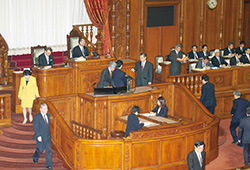
The budget for FY2016 (general account total of 96,721.8 billion yen) was passed at a plenary session of the House of Councillors on March 29 with a majority vote from our Party and other coalition partners. The FY2016 budget addresses the crucial issues confronting Japan, and continues to support the twin goals of economic revitalization and fiscal stability. The Abe Cabinet is committed to executing the new budget in a timely manner, strengthening economic policy, and establishing a virtuous economic cycle led by private-sector demand. It will also fully roll out programs for "dynamic engagement of all citizens" and for regional development to overcome population decline.
The budget addresses many of the key issues identified by Prime Minister and LDP President Shinzo Abe, including the "dynamic engagement of all citizens."
In social and safety net spending, the budget has been enriched and directed toward providing more and better daycare, enhancing nursing care services, and recruiting people to the child care and nursing care sectors. The goal is a "target birthrate of 1.8" and "no one forced to leave work to provide nursing care."
In public works, the budget provides for measures to accelerate reconstruction from the Great East Japan Earthquake, programs to enhance disaster preparedness and mitigation, efforts to rebuild and replace obsolete infrastructure, and other aspects of the "national resilience" agenda advocated by the Abe government. In agriculture, forestry and fishery, budgets have been provided for "aggressive agriculture, forestry and fishery industries," including export promotion programs in preparation for the Trans-Pacific Strategic Economic Partnership Agreement (TPP).
To bring new momentum to regional development, the FY2016 budget includes a new subsidy program for self-directed initiatives at the regional level, as well as spending to promote tourism and attract more foreign visitors to outlying destinations. The foreign affairs and defense budget has also been enhanced to actively pursue Prime Minister Abe's vision of "diplomacy that spans the globe" and to steadily increase Japan's defense capabilities.
FY2016 is the first budget under the "Plan to Advance Economic and Fiscal Revitalization" that was formulated last year. As called for in the plan, it restrains general spending growth to approximately 470 billion yen from the previous year.
On the revenue side, government bond issues will be reduced by 2.4 trillion yen compared to the previous year to restore dependence on public debt (35.6%) to the level prior to the collapse of Lehman Brothers. This represents a step forward towards the goal of bringing the primary balance into a surplus by FY2020, and will enable the country to achieve both economic revitalization and fiscal stability.
In January of this year, the FY2015 supplementary budget (total value of 3,321.3 billion yen) was approved. It includes emergency spending for "dynamic engagement of all citizens" programs, as well as expenses related to TPP. The FY2016 budget, combined with the supplementary budget, will provide seamless execution of effective policy, and will further improve efforts to achieve a "strong economy."










